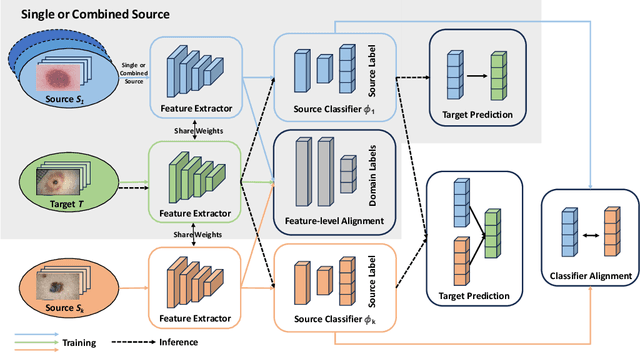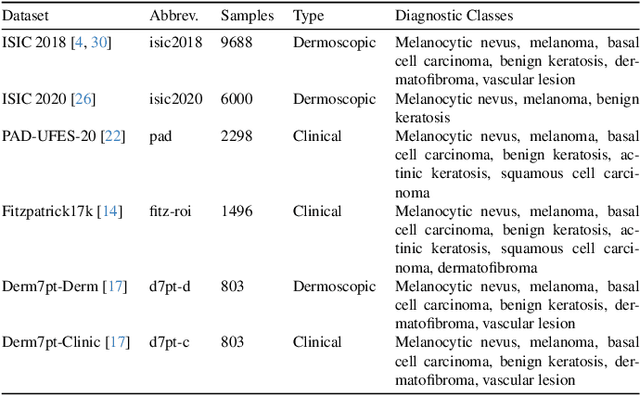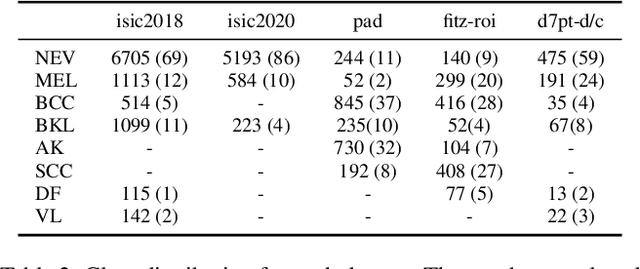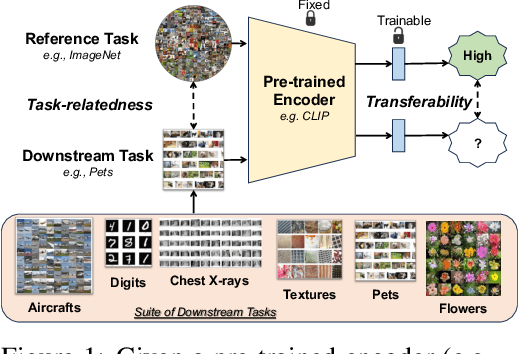Yunbei Zhang
Visual Instance-aware Prompt Tuning
Jul 10, 2025Abstract:Visual Prompt Tuning (VPT) has emerged as a parameter-efficient fine-tuning paradigm for vision transformers, with conventional approaches utilizing dataset-level prompts that remain the same across all input instances. We observe that this strategy results in sub-optimal performance due to high variance in downstream datasets. To address this challenge, we propose Visual Instance-aware Prompt Tuning (ViaPT), which generates instance-aware prompts based on each individual input and fuses them with dataset-level prompts, leveraging Principal Component Analysis (PCA) to retain important prompting information. Moreover, we reveal that VPT-Deep and VPT-Shallow represent two corner cases based on a conceptual understanding, in which they fail to effectively capture instance-specific information, while random dimension reduction on prompts only yields performance between the two extremes. Instead, ViaPT overcomes these limitations by balancing dataset-level and instance-level knowledge, while reducing the amount of learnable parameters compared to VPT-Deep. Extensive experiments across 34 diverse datasets demonstrate that our method consistently outperforms state-of-the-art baselines, establishing a new paradigm for analyzing and optimizing visual prompts for vision transformers.
SoK: Can Synthetic Images Replace Real Data? A Survey of Utility and Privacy of Synthetic Image Generation
Jun 24, 2025Abstract:Advances in generative models have transformed the field of synthetic image generation for privacy-preserving data synthesis (PPDS). However, the field lacks a comprehensive survey and comparison of synthetic image generation methods across diverse settings. In particular, when we generate synthetic images for the purpose of training a classifier, there is a pipeline of generation-sampling-classification which takes private training as input and outputs the final classifier of interest. In this survey, we systematically categorize existing image synthesis methods, privacy attacks, and mitigations along this generation-sampling-classification pipeline. To empirically compare diverse synthesis approaches, we provide a benchmark with representative generative methods and use model-agnostic membership inference attacks (MIAs) as a measure of privacy risk. Through this study, we seek to answer critical questions in PPDS: Can synthetic data effectively replace real data? Which release strategy balances utility and privacy? Do mitigations improve the utility-privacy tradeoff? Which generative models perform best across different scenarios? With a systematic evaluation of diverse methods, our study provides actionable insights into the utility-privacy tradeoffs of synthetic data generation methods and guides the decision on optimal data releasing strategies for real-world applications.
Doctor Approved: Generating Medically Accurate Skin Disease Images through AI-Expert Feedback
Jun 14, 2025Abstract:Paucity of medical data severely limits the generalizability of diagnostic ML models, as the full spectrum of disease variability can not be represented by a small clinical dataset. To address this, diffusion models (DMs) have been considered as a promising avenue for synthetic image generation and augmentation. However, they frequently produce medically inaccurate images, deteriorating the model performance. Expert domain knowledge is critical for synthesizing images that correctly encode clinical information, especially when data is scarce and quality outweighs quantity. Existing approaches for incorporating human feedback, such as reinforcement learning (RL) and Direct Preference Optimization (DPO), rely on robust reward functions or demand labor-intensive expert evaluations. Recent progress in Multimodal Large Language Models (MLLMs) reveals their strong visual reasoning capabilities, making them adept candidates as evaluators. In this work, we propose a novel framework, coined MAGIC (Medically Accurate Generation of Images through AI-Expert Collaboration), that synthesizes clinically accurate skin disease images for data augmentation. Our method creatively translates expert-defined criteria into actionable feedback for image synthesis of DMs, significantly improving clinical accuracy while reducing the direct human workload. Experiments demonstrate that our method greatly improves the clinical quality of synthesized skin disease images, with outputs aligning with dermatologist assessments. Additionally, augmenting training data with these synthesized images improves diagnostic accuracy by +9.02% on a challenging 20-condition skin disease classification task, and by +13.89% in the few-shot setting.
Describe Anything in Medical Images
May 09, 2025Abstract:Localized image captioning has made significant progress with models like the Describe Anything Model (DAM), which can generate detailed region-specific descriptions without explicit region-text supervision. However, such capabilities have yet to be widely applied to specialized domains like medical imaging, where diagnostic interpretation relies on subtle regional findings rather than global understanding. To mitigate this gap, we propose MedDAM, the first comprehensive framework leveraging large vision-language models for region-specific captioning in medical images. MedDAM employs medical expert-designed prompts tailored to specific imaging modalities and establishes a robust evaluation benchmark comprising a customized assessment protocol, data pre-processing pipeline, and specialized QA template library. This benchmark evaluates both MedDAM and other adaptable large vision-language models, focusing on clinical factuality through attribute-level verification tasks, thereby circumventing the absence of ground-truth region-caption pairs in medical datasets. Extensive experiments on the VinDr-CXR, LIDC-IDRI, and SkinCon datasets demonstrate MedDAM's superiority over leading peers (including GPT-4o, Claude 3.7 Sonnet, LLaMA-3.2 Vision, Qwen2.5-VL, GPT-4Rol, and OMG-LLaVA) in the task, revealing the importance of region-level semantic alignment in medical image understanding and establishing MedDAM as a promising foundation for clinical vision-language integration.
Dynamic Domains, Dynamic Solutions: DPCore for Continual Test-Time Adaptation
Jun 15, 2024Abstract:Continual Test-Time Adaptation (TTA) seeks to adapt a source pre-trained model to continually changing, unlabeled target domains. Existing TTA methods are typically designed for environments where domain changes occur gradually and can struggle in more dynamic scenarios. Inspired by the principles of online K-Means, this paper introduces a novel approach to continual TTA through visual prompting. We propose a Dynamic Prompt Coreset that not only preserves knowledge from previously visited domains but also accommodates learning from new potential domains. This is complemented by a distance-based weight updating mechanism that ensures the coreset remains current and relevant. Our approach employs a fixed model architecture alongside the coreset and an innovative updating system to effectively mitigate challenges such as catastrophic forgetting and error accumulation. Extensive testing across various benchmarks-including ImageNet-C, CIFAR100-C, and CIFAR10-C-demonstrates that our method consistently outperforms state-of-the-art (SOTA) alternatives, particularly excelling in dynamically changing environments.
Test-time Assessment of a Model's Performance on Unseen Domains via Optimal Transport
May 02, 2024Abstract:Gauging the performance of ML models on data from unseen domains at test-time is essential yet a challenging problem due to the lack of labels in this setting. Moreover, the performance of these models on in-distribution data is a poor indicator of their performance on data from unseen domains. Thus, it is essential to develop metrics that can provide insights into the model's performance at test time and can be computed only with the information available at test time (such as their model parameters, the training data or its statistics, and the unlabeled test data). To this end, we propose a metric based on Optimal Transport that is highly correlated with the model's performance on unseen domains and is efficiently computable only using information available at test time. Concretely, our metric characterizes the model's performance on unseen domains using only a small amount of unlabeled data from these domains and data or statistics from the training (source) domain(s). Through extensive empirical evaluation using standard benchmark datasets, and their corruptions, we demonstrate the utility of our metric in estimating the model's performance in various practical applications. These include the problems of selecting the source data and architecture that leads to the best performance on data from an unseen domain and the problem of predicting a deployed model's performance at test time on unseen domains. Our empirical results show that our metric, which uses information from both the source and the unseen domain, is highly correlated with the model's performance, achieving a significantly better correlation than that obtained via the popular prediction entropy-based metric, which is computed solely using the data from the unseen domain.
On the Fly Neural Style Smoothing for Risk-Averse Domain Generalization
Jul 17, 2023Abstract:Achieving high accuracy on data from domains unseen during training is a fundamental challenge in domain generalization (DG). While state-of-the-art DG classifiers have demonstrated impressive performance across various tasks, they have shown a bias towards domain-dependent information, such as image styles, rather than domain-invariant information, such as image content. This bias renders them unreliable for deployment in risk-sensitive scenarios such as autonomous driving where a misclassification could lead to catastrophic consequences. To enable risk-averse predictions from a DG classifier, we propose a novel inference procedure, Test-Time Neural Style Smoothing (TT-NSS), that uses a "style-smoothed" version of the DG classifier for prediction at test time. Specifically, the style-smoothed classifier classifies a test image as the most probable class predicted by the DG classifier on random re-stylizations of the test image. TT-NSS uses a neural style transfer module to stylize a test image on the fly, requires only black-box access to the DG classifier, and crucially, abstains when predictions of the DG classifier on the stylized test images lack consensus. Additionally, we propose a neural style smoothing (NSS) based training procedure that can be seamlessly integrated with existing DG methods. This procedure enhances prediction consistency, improving the performance of TT-NSS on non-abstained samples. Our empirical results demonstrate the effectiveness of TT-NSS and NSS at producing and improving risk-averse predictions on unseen domains from DG classifiers trained with SOTA training methods on various benchmark datasets and their variations.
Can Domain Adaptation Improve Accuracy and Fairness of Skin Lesion Classification?
Jul 06, 2023



Abstract:Deep learning-based diagnostic system has demonstrated potential in classifying skin cancer conditions when labeled training example are abundant. However, skin lesion analysis often suffers from a scarcity of labeled data, hindering the development of an accurate and reliable diagnostic system. In this work, we leverage multiple skin lesion datasets and investigate the feasibility of various unsupervised domain adaptation (UDA) methods in binary and multi-class skin lesion classification. In particular, we assess three UDA training schemes: single-, combined-, and multi-source. Our experiment results show that UDA is effective in binary classification, with further improvement being observed when imbalance is mitigated. In multi-class task, its performance is less prominent, and imbalance problem again needs to be addressed to achieve above-baseline accuracy. Through our quantitative analysis, we find that the test error of multi-class tasks is strongly correlated with label shift, and feature-level UDA methods have limitations when handling imbalanced datasets. Finally, our study reveals that UDA can effectively reduce bias against minority groups and promote fairness, even without the explicit use of fairness-focused techniques.
Analysis of Task Transferability in Large Pre-trained Classifiers
Jul 03, 2023



Abstract:Transfer learning transfers the knowledge acquired by a model from a source task to multiple downstream target tasks with minimal fine-tuning. The success of transfer learning at improving performance, especially with the use of large pre-trained models has made transfer learning an essential tool in the machine learning toolbox. However, the conditions under which the performance is transferable to downstream tasks are not understood very well. In this work, we analyze the transfer of performance for classification tasks, when only the last linear layer of the source model is fine-tuned on the target task. We propose a novel Task Transfer Analysis approach that transforms the source distribution (and classifier) by changing the class prior distribution, label, and feature spaces to produce a new source distribution (and classifier) and allows us to relate the loss of the downstream task (i.e., transferability) to that of the source task. Concretely, our bound explains transferability in terms of the Wasserstein distance between the transformed source and downstream task's distribution, conditional entropy between the label distributions of the two tasks, and weighted loss of the source classifier on the source task. Moreover, we propose an optimization problem for learning the transforms of the source task to minimize the upper bound on transferability. We perform a large-scale empirical study by using state-of-the-art pre-trained models and demonstrate the effectiveness of our bound and optimization at predicting transferability. The results of our experiments demonstrate how factors such as task relatedness, pretraining method, and model architecture affect transferability.
 Add to Chrome
Add to Chrome Add to Firefox
Add to Firefox Add to Edge
Add to Edge